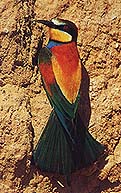Text and picture by Hanne and Jens Eriksen
 Wildlife photography in a hot and dry climate has its own problems. Temperatures over 40°C (104°F) are common in Arabia for much of the year. In direct sunlight the temperature of camera and films could get much higher.
Wildlife photography in a hot and dry climate has its own problems. Temperatures over 40°C (104°F) are common in Arabia for much of the year. In direct sunlight the temperature of camera and films could get much higher.
We always carry towels and blankets with us in the car when on a photography trip. Even when outside the car, we often cover the camera body in a towel. This also protects against other serious enemies, sand and dust. A few grains of sand can stay unnoticed inside the camera body and severely scratch a great many rolls of film. If the worst comes to the worst the sand and dust can jam up the camera totally.
By the same token, do protect yourself against the harsh environment. Wear sun block, a hat and drink plenty of water.
Another problem is what kind of film to use in a hot climate. Our experience of slide films is that Kodachrome 64 and 200 give disappointing results. The colours are washed out and look bleak. Various Ektachrome films are even worse, although we had reasonable results recently with the new Ektachrome 100 Elite.
We suggest that you try Fujichrome Velvia. It adds just enough brilliance to ground colours and the vegetation to make pictures more interesting. The film should be rated at ASA 40, not 50 as the film cartridge says. Otherwise many pictures will be too dark. This is achieved by manually setting the camera's film speed dial at 40. The same effect can be obtained by a + 1/3 compensation on the camera's light meter dial. For very pale surroundings or white birds, a 2/3 or even + 1 compensation will usually be necessary. Do try out a roll of the film and have it developed before you go on a trip if it is the first time you try Velvia. The photograph of a European Bee-eater reproduced here gives an idea of the vivid colours of Velvia.
At a rating of 40 Velvia is, of course, only half as fast as Kodachrome 64, which many photographers rate at 80 (or give a -1/3 compensation). Except for scenes with lots of action this is not really a problem in Arabia because there is usually a very high light intensity.
For a faster film Fujichrome 100 Sensia or Provia are good choices. These films should be rated as stated, that is ASA 100. Compensation is only necessary for very dark (- 1/3) or very pale (+1/3) situations. Fujichrome 400 is too grainy for our liking (as is Kodachrome 200 and Ektachrome 400).
For print film we have much less experience, but it seems that print films are more tolerant of extremes. Whatever film you choose make sure that they are kept in a cool place when travelling, preferably in a cool box.
On a recent photosafari to a hot and dry country we gave two Fujichrome Velvias to a well-known bird photographer who only used Kodachrome. Reluctantly, he used the two films. Upon return he wrote that they were the best he had taken on the entire trip! He, too, is now hooked on Velvia. We hardly use anything else. Try it!
| Back to HOME | Contact us: EMAIL | Subscribe to ARABIAN WILDLIFE MAGAZINE | LINK your site to ours | Leave a message on our WEB BOARD | Visit our BOOK SHOP | Back to INDEX |
Web Links | Subjects | Search
Arabian Wildlife. Volume 2, Number 3